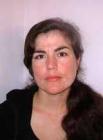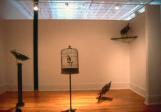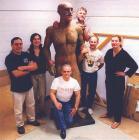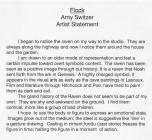1
Amy Switzer, the second youngest of four children was born in 1971 in Midland, Ontario as Amy Elizabeth Switzer. She was raised in Simcoe County, outside of Barrie, Ontario.From 1991 to 1996, she earned an Honors Bachelor of Fine Art at the University of Guelph, with majors in Fine Art and Art History and an Honors Thesis in sculpture. She graduated with the Dimensions Award, the Graduate Student Book Award from the Faculty of Fine Art, and the Patricia and Von Odette Award from the Sculptors Society of Canada. She later won the Odette Best Sculpture Award in the Toronto Outdoor Art Exhibition in 2000.
In 1998, she worked as an instructor at the MacLaren Art Centre in Barrie, Ontario. From 1997 to 1999, she worked as an assistant to sculptor John McEwen in Hillsdale, Ontario. From 1997 to 2000, she worked as an art educator in Van Go at the MacLaren Art Centre Outreach Education Program and served as its materials coordinator from 2000 to 2002. Also between 2000 and 2002, she was a sessional instructor at Canadore College in North Bay, Ontario, and an instructor in their Artsperience summer program. In 2001, she traveled to India and Nepal. From 2001 to 2003, she worked as an instructor at the School of Design & Visual Art at Georgian College in Barrie, Ontario.
From 2002 to the present, she has been doing a Masters of Fine Art at the University of Waterloo in Waterloo, Ontario in sculpture.
In 2003, she lived in England for two months, working as an assistant to sculptor Nicola Hicks in Appleby. From 2001 to the present, she has worked as a professor and coordinator in Art & Design Fundamentals, School of Design and Visual Art at Georgian College.
From 2000 to 2002, she served as co-chairperson of the programming committee and the education committee at White Water Gallery in North Bay.
Solo exhibitions of her work include Amy Switzer: New Sculpture and Drawing, Sarah Beveridge Contemporary Art (Barrie, Ontario), Place: New Sculpture and Drawings by Amy Switzer, MacLaren Art Center Campus Gallery, (Barrie, Ontario, 2005); Paths, Patterns and Places, MacLaren Art Centre (Barrie, ON, 2004); Amy Switzer: New Sculpture, Joan Ferneyhough Gallery (North Bay, Ontario, 2002); Amy Switzer: New Sculpture, Joan Ferneyhough Gallery (North Bay, Ontario, 2000), The Toronto Outdoor Art Exhibit, Nathan Phillips Square, (2000, Toronto), Guardians: New Sculpture, Gallery - 100 Yonge, Scotia Plaza, (Toronto, 2000); Flock: Recent Sculpture by Amy Switzer, White Water Gallery (North Bay, 1999).
She has received the following grants: Exhibition Assistance Grant (1999, Ontario Arts Council and Grant for Emerging Artists (Elizabeth Greenshields Foundation, 2000).
In addition to private commissions, Amy has created commissions in public parks, including "Guardians" in the "Home Garden" of The Humber Bay Shores East in Toronto (2002) and work in The Milne Hollow Park (2007).
Amy is represented by Sarah Beveridge Contemporary Art in Barrie, Ontario.
(The biographical information featured here was written in consultation with the artist in 2006.)
Interview:
Q: What is your favourite medium to work with and why?
A: Drawing and sculpture are both my favorites for very different reasons. Drawing is immediate; I am able to realize an idea quickly and that is gratifying. Sculpture is technically more involved which becomes a factor in making a work. A sculpture requires more planning and for that reason it is not as spontaneous as my drawing. I love sculpture because it exists in space and the viewer is able to engage with it physically.
Q: How do you find inspiration?
A: I find inspiration in human relationships and in Nature through observation and experience. I am very interested in how subconscious gestures can communicate what words cannot.
Q: What do you find the most rewarding about teaching?
A: It is wonderful when a student realizes their potential, gets excited and finds joy in the making of art. I also really enjoy working with a group of like-minded people. The support and encouragement that comes out of this type of environment is very special.
Q: Did your traveling, particularly to India and Nepal, affect or inspire your artwork?
A: I feel that any life experience, such as traveling, affects my artwork. Beyond the history and culture of these countries, I think the landscape of the Thar Desert and the crowded streets of New Delhi and Mumbai influenced several of my works. I was also very intrigued by the role that animals play in these cultures.
Q: Your sculpture, Raven VI is beautiful. What were you trying to capture with this piece?
A: The Raven series began through my observation of the birds interacting outside of my studio. I was intrigued by their gestures so I began to draw them. These drawings led to the welded steel sculpture series. Creating these sculptures was a way for me to explore the relationships between animals and humans and the ways we have charged them with symbolism and anthropomorphic characteristics. I am very interested in the ways in which humans have personified animals and what motivates our desire to do this.
Q: What is the process you go through from the beginning to the end of a sculpture?
A: I don't really have a prescriptive method; I usually begin my process with drawing to work through my ideas. For sculpture I will often begin with a maquette to try to work out technical and formal issues. I then use the maquette as a starting point for the larger sculpture. I usually work on several pieces simultaneously and as one work evolves it informs the other work.
Q: Other than your artwork, what other interests do you have?
A: I have a strong interest in the Natural world. I spend a lot of time outdoors drawing within the landscape. I enjoy reading philosophy and a variety of literature. I am constantly studying the work of other artists, both contemporary and historical. Travel is also very important to me.
Q: Could you tell us more about your sculptures?
A: With my sculpture I want to explore human psychology and the dimensions of the human condition. I am interested in making work that speaks to the connection between natural history and human nature. The body language of my animal and human subjects can be read as metaphors for human experience and I hope the viewer would draw on his or her own experience to complete the narrative.
(Interview with Kathryn Copeland, January 2007).



